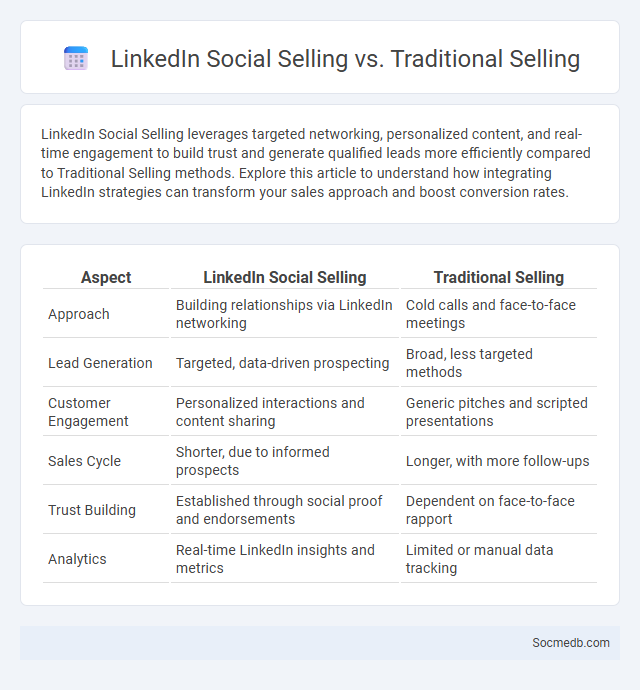
Photo illustration: LinkedIn Social Selling vs Traditional Selling
LinkedIn Social Selling leverages targeted networking, personalized content, and real-time engagement to build trust and generate qualified leads more efficiently compared to Traditional Selling methods. Explore this article to understand how integrating LinkedIn strategies can transform your sales approach and boost conversion rates.
Table of Comparison
| Aspect | LinkedIn Social Selling | Traditional Selling |
|---|---|---|
| Approach | Building relationships via LinkedIn networking | Cold calls and face-to-face meetings |
| Lead Generation | Targeted, data-driven prospecting | Broad, less targeted methods |
| Customer Engagement | Personalized interactions and content sharing | Generic pitches and scripted presentations |
| Sales Cycle | Shorter, due to informed prospects | Longer, with more follow-ups |
| Trust Building | Established through social proof and endorsements | Dependent on face-to-face rapport |
| Analytics | Real-time LinkedIn insights and metrics | Limited or manual data tracking |
Understanding Social Selling: Definition and Core Principles
Social selling leverages social media platforms to build relationships and engage prospects, enhancing the sales process through personalized interactions and relevant content sharing. Core principles of social selling include establishing trust, providing value through insightful communication, and maintaining consistent engagement to nurture leads. By effectively utilizing LinkedIn, Twitter, and Facebook, sales professionals can increase conversion rates and shorten sales cycles through targeted social engagement.
What is LinkedIn Social Selling? Key Features and Strategies
LinkedIn social selling leverages the platform's professional network to build relationships and generate leads by sharing valuable content, engaging with prospects, and establishing credibility. Key features include advanced search filters, Sales Navigator for targeted outreach, and InMail messaging for personalized communication. To maximize your LinkedIn social selling strategy, focus on consistently posting relevant content, actively networking with decision-makers, and using data-driven insights to tailor your approach.
Traditional Selling Explained: Methods and Limitations
Traditional selling relies on in-person interactions, face-to-face negotiations, and direct customer contacts, emphasizing relationship-building through physical presence. Your ability to reach a broad audience is limited by geographical boundaries and time constraints, which can hinder sales potential in a globalized market. Social media overcomes these limitations by enabling targeted outreach, real-time engagement, and scalable communication beyond traditional methods.
Comparing LinkedIn Social Selling vs Traditional Selling
LinkedIn social selling leverages targeted networking and personalized engagement with potential buyers through advanced algorithms to identify and connect with decision-makers, increasing lead quality by up to 45%. Traditional selling relies heavily on cold calls and broad outreach efforts, often resulting in lower conversion rates and longer sales cycles. Data shows LinkedIn social selling users experience a 51% higher likelihood of achieving sales quotas compared to traditional methods, highlighting the platform's efficiency in nurturing relationships and driving revenue.
Benefits of LinkedIn Social Selling Over Traditional Approaches
LinkedIn social selling enhances lead generation by leveraging professional networks and data-driven insights to target decision-makers more effectively than traditional cold calling or email campaigns. Its platform features, such as InMail and content sharing, foster personalized engagement that builds trust and long-term relationships with prospects. Analytics tools track buyer interactions, enabling sales teams to refine strategies and improve conversion rates, outperforming conventional sales approaches.
How Social Selling Differs from Traditional Selling
Social selling leverages social media platforms to build relationships, engage with potential customers, and provide personalized interactions, contrasting traditional selling's reliance on direct, in-person methods and cold-calling techniques. It uses data-driven insights and real-time communication to target your audience more effectively and nurture leads through consistent online engagement. Your ability to create trust and credibility on social networks makes social selling a more dynamic and customer-centric approach than conventional sales models.
Key Metrics to Measure Success in LinkedIn Social Selling
Key metrics to measure success in LinkedIn social selling include engagement rate, connection growth, and lead conversion rate. Monitoring profile views and content interactions helps assess brand visibility, while tracking message response rates and opportunities created reveals sales effectiveness. Consistent analysis of these metrics enables optimization of LinkedIn strategies for higher revenue impact.
Integrating LinkedIn Social Selling with Traditional Sales Tactics
Integrating LinkedIn social selling with traditional sales tactics enhances your ability to build authentic relationships and identify high-quality leads through targeted profile engagement and content sharing. Leveraging LinkedIn's advanced search filters and analytics tools allows you to pinpoint decision-makers while traditional sales methods like in-person meetings and phone calls maintain personal trust and rapport. Combining these strategies maximizes conversion rates and accelerates the sales cycle by blending digital insights with proven interpersonal techniques.
Common Challenges in Social Selling and How to Overcome Them
Common challenges in social selling include building authentic relationships, managing time effectively, and measuring return on investment (ROI). Overcoming these obstacles requires leveraging data analytics to target the right audience, utilizing customer relationship management (CRM) tools to streamline interactions, and implementing clear KPIs to track campaign success. Consistent engagement combined with personalized content fosters trust and drives conversion rates on platforms like LinkedIn, Instagram, and Facebook.
Future Trends: The Evolution of Social Selling in B2B Sales
Social selling in B2B sales is evolving rapidly with the integration of AI-driven analytics and personalized content strategies to enhance customer engagement and decision-making. Platforms like LinkedIn are leveraging advanced algorithms to identify high-potential leads and facilitate authentic relationship-building at scale. You can harness these future trends to improve your sales pipeline and achieve deeper connections with key industry stakeholders.
 socmedb.com
socmedb.com